-
On 1789, the assembly issued to create a constitution. Up until 1791, the Constituent Assembly had many crisis. The King was replaced, who tried to weaken the government, and escape. Who also prepared the Declaration of the Rights of Man and of the Citizen and the Constitution of 1791, faced the fiscal crisis by issuing the assignats, and developing a new fiscal strategy. The results were mixed, but the Constituent Assembly was the first true legislature in French history.
-
 Was an act of rebellion by the commoners during the Estates General. They knew that any attempt at reform would be rejected by the privileged classes, so a National Assembly was formed. On 20 June, they weren't available to enter, thinking it was on purpose; they moved to a tennis court. Remaining there until the French Constitution was established. Due to the perseverance, Louis XVI agreed and on 27 June ordered the high classes to join them in the National Assembly.
Was an act of rebellion by the commoners during the Estates General. They knew that any attempt at reform would be rejected by the privileged classes, so a National Assembly was formed. On 20 June, they weren't available to enter, thinking it was on purpose; they moved to a tennis court. Remaining there until the French Constitution was established. Due to the perseverance, Louis XVI agreed and on 27 June ordered the high classes to join them in the National Assembly. -
 Was an assembly that acted as a council for the monarchy. Due to the poor financial situation, Louis XVI convoked the Estates General, which hadn't been convoked for 175 years. The formal opening was held on 5 May 1789. Where in the voting system, the commoners demanded one vote per person, as it was one vote per Estate, and it was unfair. Louis refused it, so the National Assembly was formed, marking the end of the Ancien Régime and the start of the French Revolution.
Was an assembly that acted as a council for the monarchy. Due to the poor financial situation, Louis XVI convoked the Estates General, which hadn't been convoked for 175 years. The formal opening was held on 5 May 1789. Where in the voting system, the commoners demanded one vote per person, as it was one vote per Estate, and it was unfair. Louis refused it, so the National Assembly was formed, marking the end of the Ancien Régime and the start of the French Revolution. -
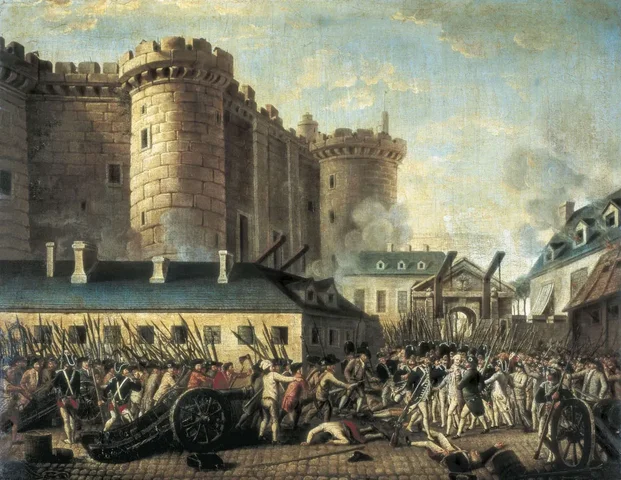 The act of rebellion began when Parisians thought they would be arrested at the National Assembly. Seeking for protection, they decided to steal gunpowder and cannons from the Bastille, presenting the final symbol of royal tyranny and coercive power for the French people. The great attack by the commoners on the royal guards was a victory. The fall demanded to reinstate Jacques Necker as minister, however the people now had power and the French Revolution truly began.
The act of rebellion began when Parisians thought they would be arrested at the National Assembly. Seeking for protection, they decided to steal gunpowder and cannons from the Bastille, presenting the final symbol of royal tyranny and coercive power for the French people. The great attack by the commoners on the royal guards was a victory. The fall demanded to reinstate Jacques Necker as minister, however the people now had power and the French Revolution truly began. -
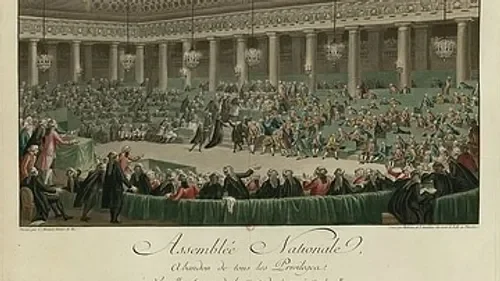 Due to peasant revolts, attacking feudal properties, the National Assembly was forced to act. The night of 4th August, the diputies agreed to remove the privileges of the nobility and clergy as a solution, and they declared the “abolition of feudalism”. However, the exact meaning was unclear, as France had not a feudal system since centuries, so by just trying to figure out how to put it into practice, they spent 2 more years.
Due to peasant revolts, attacking feudal properties, the National Assembly was forced to act. The night of 4th August, the diputies agreed to remove the privileges of the nobility and clergy as a solution, and they declared the “abolition of feudalism”. However, the exact meaning was unclear, as France had not a feudal system since centuries, so by just trying to figure out how to put it into practice, they spent 2 more years. -
 Before creating a new Constitution for France, the Assembly established the fundamental principles, forming the Declaration of the Rights of Man and of the Citizen. The process took required five deputies to unify the proposals into a single document, which was debated and voted between 20 and 26 August. At the end it contained 17 articles, considered natural and inalienable. After its confirmation, the text introduced the first Constitution of the French Revolution in 1791.
Before creating a new Constitution for France, the Assembly established the fundamental principles, forming the Declaration of the Rights of Man and of the Citizen. The process took required five deputies to unify the proposals into a single document, which was debated and voted between 20 and 26 August. At the end it contained 17 articles, considered natural and inalienable. After its confirmation, the text introduced the first Constitution of the French Revolution in 1791. -
 Louis XVI and Marie Antoinette were controlled at the Tuileries Palace in Paris, feeling like prisoners. And the royal family decided to escape abroad, so Axel Von Fersen designed the plan. On the night of 20 June, the ploan initiated, wanting to cross the border 50 km away. However, they were captured in Varennes and forced to return. The people felt betrayed, so they locked them up and proclaimed the Republic. Later, the king and queen were executed.
Louis XVI and Marie Antoinette were controlled at the Tuileries Palace in Paris, feeling like prisoners. And the royal family decided to escape abroad, so Axel Von Fersen designed the plan. On the night of 20 June, the ploan initiated, wanting to cross the border 50 km away. However, they were captured in Varennes and forced to return. The people felt betrayed, so they locked them up and proclaimed the Republic. Later, the king and queen were executed. -
The first elections to the Legislative Assembly were held under the new constitution. Factional conflicts were experiensed and hostility towards the king, who exercised his veto against legislative reforms. The Assembly declared war on foreign powers (Austria and Prussia). It came to an end after the insurrection of 10 August 1792, which suspended the king, paving the way for the dissolution of the constitutional monarchy and the establishment of the National Convention and the Republic.
-
Replaced the other assembly and controlled France. It was the first French assembly elected under universal male suffrage and established the First French Republic. The Girondins and Montagnards clashed internally, with Montagnards gaining power in 1793, leading to the Republic's establishment, the King's execution, and Terror. Ended in 1795 following the adoption of the Constitution and the Thermidorian Reaction, which was a coup d'état that toppled and executed Robespierre.
-
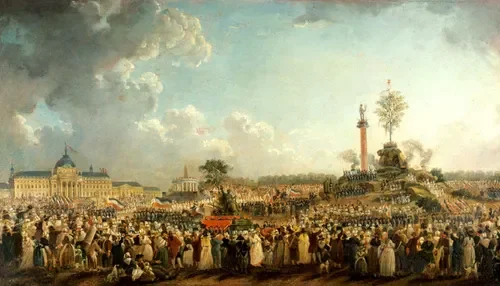 The Legislative Assembly declared the war marking the beginning of the French Revolutionary War. This was due to causes as the threat of invasion, the Declaration of Pillnitz, and the Girondins seeking to spread their ideals. Moreover, the king agreed, betraying his country in the hope that defeat would bring back absolut monarchy. The declaration accelerated the Revolution, leading to the collapse of the monarchy and the continuing with the execution of the king, Louis XVI.
The Legislative Assembly declared the war marking the beginning of the French Revolutionary War. This was due to causes as the threat of invasion, the Declaration of Pillnitz, and the Girondins seeking to spread their ideals. Moreover, the king agreed, betraying his country in the hope that defeat would bring back absolut monarchy. The declaration accelerated the Revolution, leading to the collapse of the monarchy and the continuing with the execution of the king, Louis XVI. -
 Known as the ‘Second French Revolution’ as it broke the constitutional monarchy. The main cause was political paralysis and popular outrage. Also, due to a threat of rising and mistrust for fear of king's collaboration with foreigners.
Known as the ‘Second French Revolution’ as it broke the constitutional monarchy. The main cause was political paralysis and popular outrage. Also, due to a threat of rising and mistrust for fear of king's collaboration with foreigners.
It took place in the early hours: when the court escaped protected by the Assembly. An alarm alerted the people, who started violent fighting around and inside the palace. The King's Swiss Guard opened fire on the crowd, causing a pitched battle. -
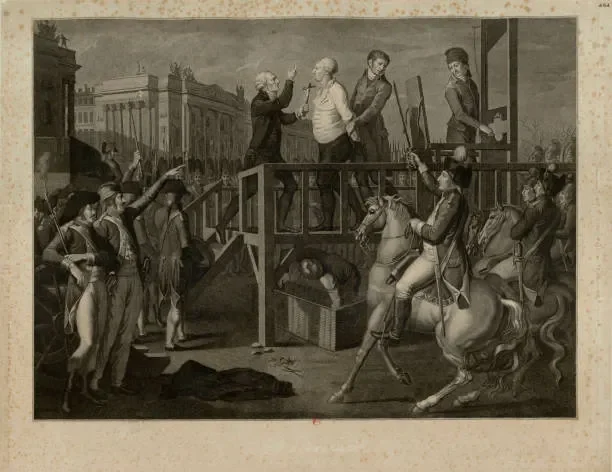 The public execution of Louis XVI was the final step in the fall of the monarchy and unification of the First French Republic. Due to being accused as traitor. Where the king was guilty by a majority vote and sentenced to death. He was taken to the guillotine, but remained calm and respectful.
The public execution of Louis XVI was the final step in the fall of the monarchy and unification of the First French Republic. Due to being accused as traitor. Where the king was guilty by a majority vote and sentenced to death. He was taken to the guillotine, but remained calm and respectful.
Bringing the end of the monarchy, ceding the Republic. This act contributed to intensifying the atmosphere of fear and violence that led to the period known as The Terror. -
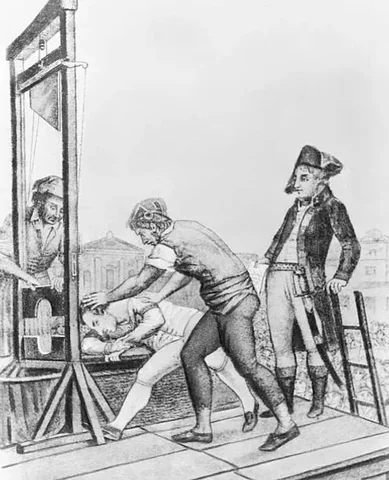 It is known as the Thermidorian Reaction and marked the end of the Reign of Terror. The cause was the attack on his own close collaborators in the government, who feared to be executed. Deciding to arrest Robespierre, and other key allies. Then, supporters in the government joined together to free them, but failed thier goal. On the next day, were executed with the gillotin. Leading to pass the power to the moderates, who removed institutions and guarded the government.
It is known as the Thermidorian Reaction and marked the end of the Reign of Terror. The cause was the attack on his own close collaborators in the government, who feared to be executed. Deciding to arrest Robespierre, and other key allies. Then, supporters in the government joined together to free them, but failed thier goal. On the next day, were executed with the gillotin. Leading to pass the power to the moderates, who removed institutions and guarded the government. -
Next to the National Convention came the Directory, which sought a degree of stability while also a bourgeois order, steering clear of both monarchical absolutism and Jacobin radicalism. The Directory had a bicameral legislature comprising the Council of Five Hundred, while the Elders approved the laws. However, the Directory fell to Napoleon’s Coup of 18 Brumaire for economic crises, military dependence, political instability, and the resulting chaotic structure of the state.
-
After the 18 Brumaire coup in 1799, it became the government of the First French Republic. There were three consuls, Bonaparte had all the power as First Consul. Named Consul for Life in 1802, Bonaparte began a period of purported authoritarian rule. The Consulate period was noted for stability which followed the Revolutionary Wars and by the enactment of the Napoleonic Code and the Concordat of 1801. The Consulate period came to an end in May of 1804 when Napoleon crowned himself Emperor.
-
The Empire reinforced Napoleon's authority. After the autocratic regime, he was named emperor, merging revolutionary ideals and a hereditary monarchy. Was the most powerful in Europe, dominating the continent and being the first to achieve military victories (battle of Austerlitz) and France's extensive Napoleonic Code. But it all began to fall apart with the invasion of Russia of 1812. After an failed campaign in 1813, he abdicated in 1814 and was defeated at Waterloo in 1815.
-
 It was a victory for Napoleon I. The French Grande Armée vs the combined Austro-Russian army. This was the consequence of the capture of Vienna. Napoleon used a strategy, making appear weak to draw them in. When the allies committed the majority of their forces to the attack, he launched a counterattack through the middle which effectively split the allied forces in two. Defeating them was the final blow to the Third Coalition, cementing French supremacy in Europe for years to come.
It was a victory for Napoleon I. The French Grande Armée vs the combined Austro-Russian army. This was the consequence of the capture of Vienna. Napoleon used a strategy, making appear weak to draw them in. When the allies committed the majority of their forces to the attack, he launched a counterattack through the middle which effectively split the allied forces in two. Defeating them was the final blow to the Third Coalition, cementing French supremacy in Europe for years to come. -
 The British Navy gained this important battle. Napoleon I wanted to control the English Channel. The UK created a naval blockade. The battle was fought off the coast of Spain. The British fleet defeated them. Nelson employed a tactic by sailing in two columns to break through the enemy line, creating chaos among the enemy. The British won a crushing victory, achieving complete naval supremacy for the rest of the Napoleonic Wars. Napoleon was unable to invade Britain, but Nelson died.
The British Navy gained this important battle. Napoleon I wanted to control the English Channel. The UK created a naval blockade. The battle was fought off the coast of Spain. The British fleet defeated them. Nelson employed a tactic by sailing in two columns to break through the enemy line, creating chaos among the enemy. The British won a crushing victory, achieving complete naval supremacy for the rest of the Napoleonic Wars. Napoleon was unable to invade Britain, but Nelson died. -
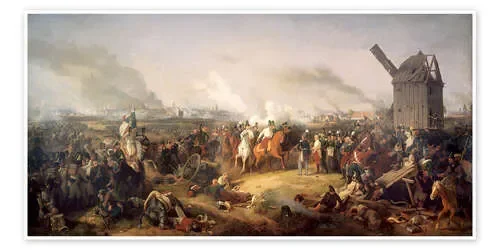 It marked the climax of the Napoleonic Wars. The battle was the peak of the Sixth Coalition's campaign to defeat Napoleon. The Coalition forces annihilated Napoleon's army, which had very few troops. The consequences were that the defeat forced Napoleon to relinquish his dominance over Germany, further sealing the fragmentation of his influence over central Europe and directly paving the way for the invasion of France, which culminated in his first abdication in 1814.
It marked the climax of the Napoleonic Wars. The battle was the peak of the Sixth Coalition's campaign to defeat Napoleon. The Coalition forces annihilated Napoleon's army, which had very few troops. The consequences were that the defeat forced Napoleon to relinquish his dominance over Germany, further sealing the fragmentation of his influence over central Europe and directly paving the way for the invasion of France, which culminated in his first abdication in 1814. -
 This was the last Napoleonic War. Because of the One Hundred Days when Napoleon returned to regain France, the Seventh Coalition was mobilised against him, causing him to attempt to beat the alliances before they combined. Napoleon's army was beaten by the combined Anglo-Allied and Prussian forces. It was the arrival of the Prussian forces that shattered the French resolve and finally drove Napoleon to resign and go into exile again and definitively. This brought the definitive end.
This was the last Napoleonic War. Because of the One Hundred Days when Napoleon returned to regain France, the Seventh Coalition was mobilised against him, causing him to attempt to beat the alliances before they combined. Napoleon's army was beaten by the combined Anglo-Allied and Prussian forces. It was the arrival of the Prussian forces that shattered the French resolve and finally drove Napoleon to resign and go into exile again and definitively. This brought the definitive end.